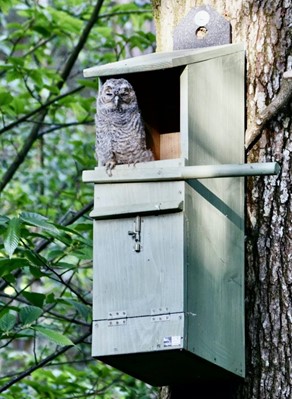3 Minute Read
By Seshi Humphrey-Ackumey, GWCT Farmland Ecology Placement Student
This year we would like to focus on the tawny owl, a species whose population is thought to be in decline in the UK. Research is needed to better understand the drivers of this trend, but a lack of suitable roosting sites due to the loss of mature trees, and changes in woodland management could be contributing factors. Conservation measures such as nest boxes are an easy way to provide suitable roosting sites for tawny owls to encourage them to breed.
As a popular choice, we share design specifications, siting considerations and maintenance advice for a tawny owl upright nest box:

The box needs to be made of suitable materials to ensure longevity. Tawny owls can nest in narrower boxes than barn owls, but they still need to be large enough for the owlets to stretch their wings and the adults to land (See Figure 1).
Important dimensions/features to include:
- An entrance hole approximately 200mm squared to allow the owls access.
- Base to be a minimum of 255mm x 255mm.
- The box should be 800mm tall.
- A hatch, 100mm – 200mm from the floor should be included for inspection and maintenance.
- A side pole should be fitted by the entrance to act as a landing perch for the owls.
Click here to download the RSPB plans for a tawny owl upright nest box.
The box should be placed within suitable foraging habitat for the owls. Tawny owls primarily forage in broadleaf woodland but also forage anywhere there are large trees such as conifer plantations parks, wooded gardens, and farmland hedgerows.
The boxes should be:
- Attached to a mature tree, within broadleaf woodland or other forested areas, and not on the fringes.
- Near branches so 4-5 week old owls can ‘branch’ – the stage at which fledglings begin to leave the nest to familiarise themselves with their surroundings and strengthen their wings.
- Out of the prevailing wind – in the UK this means you should face it away from the west or south-west.
- In an area of low disturbance.
- Placed 3m from the ground or above – higher boxes may provide more protection from predators.
- Away from roads to reduce mortalities and disturbance.
Maintenance:
To ensure the tawny owl box stays clean and sturdy, maintenance is needed. It is best to carry out any maintenance in early autumn but if you haven’t done so already, now is a good time to check and clean out any nest boxes already in place, ready for the upcoming breeding season.
You need to:
- Check the box is well-fixed, in good condition and, dry inside.
- Clear out any old nesting material.
Everyone at the Owl Box Initiative would like to wish all a happy National Nest Box Week, and please do send us pictures of your bird boxes to jcase@gwct.org.uk so we can share and celebrate them on our website and social media.
Support the Owl Box Initiative
You can help support the project by purchasing an Owl Box Initiative Supporter Badge or Living Nature Soft Toy Barn Owl from the GWCT.

Wildlife needs a helping hand from us all,we have destroyed a lot of their habitat,so let’s all help them out now